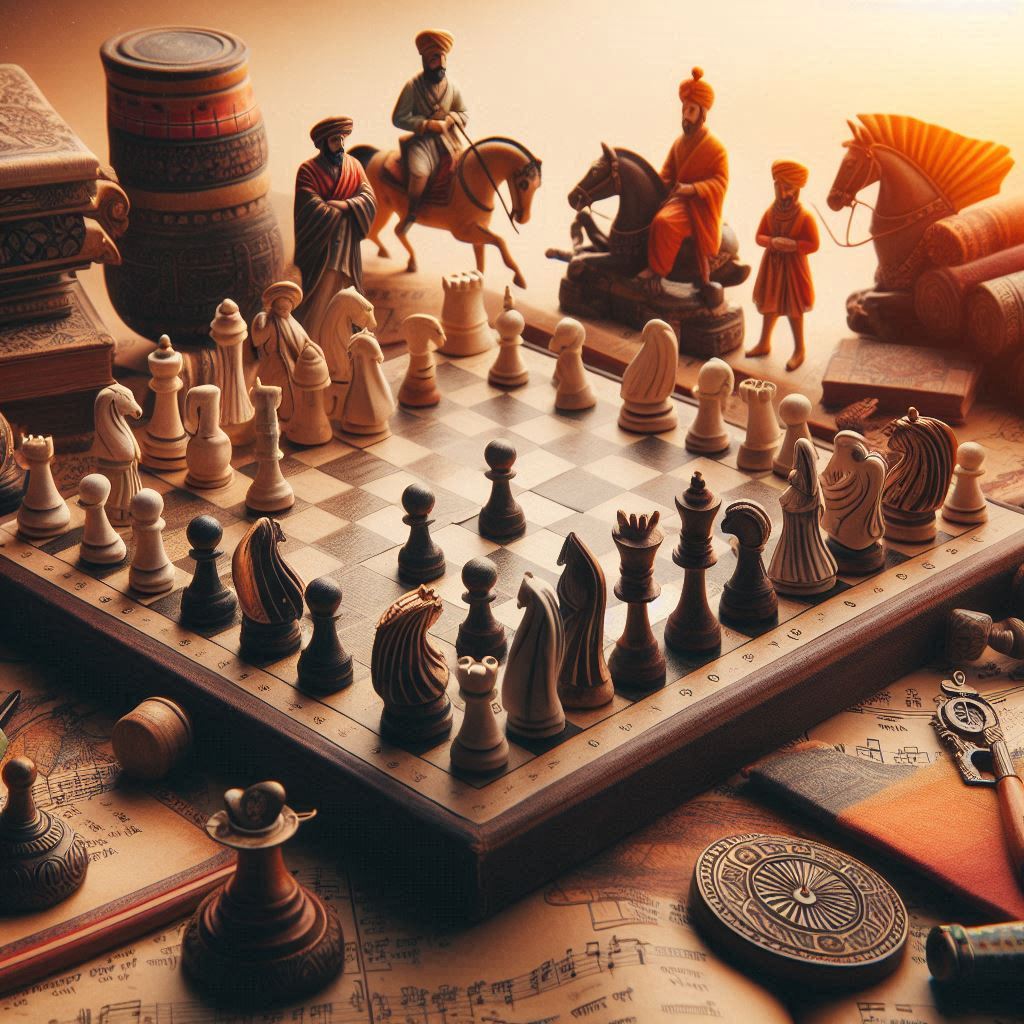Introduction
Chess is a game that has transcended centuries and cultures, evolving from a simple pastime into a global phenomenon. Its rich history spans from ancient India to modern times, reflecting the intellectual and cultural developments of the societies that embraced it. This blog explores the origins, evolution, and milestones of chess, highlighting its journey from a royal game in ancient India to the competitive sport it is today.
Thank you for reading this post, don't forget to subscribe!Origins of Chess in Ancient India
Chaturanga: The Birth of Chess
Chaturanga, an ancient Indian game dating back to the 6th century AD, is widely considered the precursor to modern chess. The game’s name, meaning “four divisions of the military,” referred to the four types of units used in play: infantry, cavalry, elephants, and chariots. These units eventually evolved into the modern pawn, knight, bishop, and rook.
Spread to Persia and the Islamic World
As trade and conquest facilitated cultural exchange, Chaturanga spread to Persia, where it became known as Shatranj. The Persians adopted and modified the game, introducing new rules and pieces. When the Islamic empire expanded, Shatranj traveled further, reaching the Middle East, North Africa, and parts of Europe.
Chess in Medieval Europe
Introduction to Europe
Chess arrived in Europe by the 9th century, brought by the Moors through Spain and Sicily. It quickly gained popularity among the nobility and was often associated with intellectual prowess and strategic thinking.
Evolution of the Pieces
In medieval Europe, chess underwent significant changes. The pieces’ names and appearances were adapted to reflect European medieval society. For instance, the vizier piece was replaced by the queen, and the elephant became the bishop.
Development of Modern Rules
By the late 15th century, significant changes in the game’s rules transformed chess into its modern form. The most notable changes included:
- The Queen: The queen became the most powerful piece on the board, capable of moving any number of squares in any direction.
- The Bishop: The bishop’s movement was extended to any number of squares diagonally.
- Pawns: Pawns were allowed to move two squares on their first move, and the en passant rule was introduced.
These changes made the game faster and more dynamic, contributing to its growing popularity.
Renaissance and Enlightenment
Chess in the Renaissance
During the Renaissance, chess became a popular subject in literature and art. It was considered a noble pastime, reflecting the era’s values of strategy and intellect. Notable figures, including Leonardo da Vinci and Benjamin Franklin, were avid chess players.
The First Chess Books
The first printed chess books appeared in the late 15th and early 16th centuries. One of the most famous early works is “Repetición de Amores y Arte de Ajedrez” by Spanish priest Ruy López de Segura. These books laid the groundwork for chess theory and strategy.
19th Century: The Birth of Competitive Chess
Formation of Chess Clubs
The 19th century saw the formation of the first chess clubs and the organization of regular tournaments. Chess clubs provided a social hub for enthusiasts to play and discuss the game.
The First International Tournament
In 1851, the first international chess tournament was held in London, marking a significant milestone in the history of chess. Organized by English player Howard Staunton, the tournament attracted leading players from around the world and helped establish competitive chess as a serious pursuit.
Paul Morphy: The First Chess Genius
American chess prodigy Paul Morphy emerged as one of the first chess geniuses during this period. His dominance in international competitions and his deep understanding of chess strategy earned him widespread acclaim and helped elevate the status of the game.
20th Century: The Rise of Chess as a Sport
Founding of FIDE
In 1924, the Fédération Internationale des Échecs (FIDE), or International Chess Federation, was founded in Paris. FIDE became the governing body for international chess competitions, standardizing rules and organizing world championships.
World Chess Championships
The 20th century saw the establishment of the World Chess Championship as the pinnacle of competitive chess. The first official championship match, held in 1886, was contested between Wilhelm Steinitz and Johannes Zukertort. Steinitz became the first official World Chess Champion, and the title has since been held by many legendary players, including Emanuel Lasker, José Raúl Capablanca, Alexander Alekhine, and Bobby Fischer.
The Fischer-Spassky Match
The 1972 World Chess Championship match between American Bobby Fischer and Soviet Boris Spassky is one of the most famous in chess history. Dubbed the “Match of the Century,” it was a symbol of Cold War tensions and brought unprecedented attention to the game. Fischer’s victory ended Soviet dominance in chess and inspired a new generation of players.
Modern Chess and Technology
The Rise of Chess Computers
The advent of computers revolutionized chess in the late 20th and early 21st centuries. Early programs like IBM’s Deep Blue challenged human players and, in 1997, Deep Blue defeated World Champion Garry Kasparov in a highly publicized match.
Online Chess and Streaming
The rise of the internet has transformed how chess is played and consumed. Online platforms like Chess.com and Lichess allow players from around the world to compete in real-time. Streaming services and platforms like Twitch have also popularized chess, with grandmasters and enthusiasts broadcasting their games and providing live commentary.
The Magnus Carlsen Era
Norwegian grandmaster Magnus Carlsen has dominated the chess world in recent years. Known for his deep understanding of the game and versatile playing style, Carlsen became the World Chess Champion in 2013 and has successfully defended his title multiple times.
FAQs
Where did chess originate?
Chess originated in ancient India around the 6th century AD with a game called Chaturanga. It spread to Persia, where it became known as Shatranj, and eventually reached Europe and the rest of the world.
How did chess evolve in Europe?
Chess evolved in Europe during the medieval period, with significant changes to the pieces and rules. By the late 15th century, the modern rules of chess were established, making the game faster and more dynamic.
What is FIDE?
FIDE, the Fédération Internationale des Échecs, is the International Chess Federation. Founded in 1924, it is the governing body for international chess competitions and organizes the World Chess Championships.
Who was Paul Morphy?
Paul Morphy was an American chess prodigy who emerged as one of the first chess geniuses in the 19th century. His dominance in international competitions and deep understanding of chess strategy earned him widespread acclaim.
What impact did computers have on chess?
The advent of computers revolutionized chess, with programs like IBM’s Deep Blue challenging human players. Today, chess engines and online platforms play a significant role in how the game is played and studied.
Who is Magnus Carlsen?
Magnus Carlsen is a Norwegian grandmaster who has dominated the chess world in recent years. He became the World Chess Champion in 2013 and has successfully defended his title multiple times.
Conclusion
The history of chess is a rich tapestry of cultural exchange, intellectual development, and technological innovation. From its origins in ancient India to its current status as a global sport, chess has captivated minds and inspired players for centuries. As the game continues to evolve, it remains a testament to human creativity, strategy, and the enduring allure of intellectual challenge.



